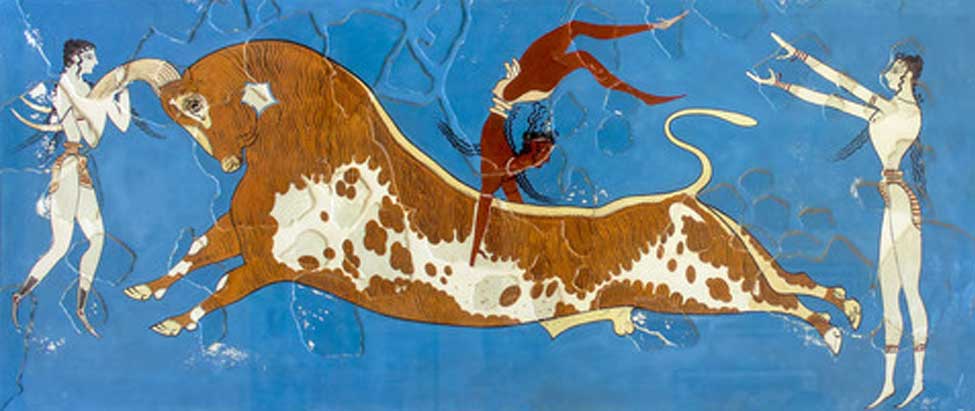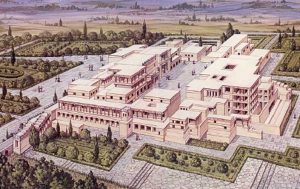The civilization of the Minoans
At the time when the Cycladic civilization was in great development, another more brilliant civilization was born in Crete. It was named Minoan after the mythical king Minos, the son of Europa and Zeus. In reality, all the kings of Crete were called Minoans for many centuries.
Located in the middle of the Mediterranean, Crete, due to its position, quickly became a great naval and commercial power.
Crete was inhabited for the first time in the Neolithic era. The most important settlement seems to have been Knossos, just as it was in the Bronze Age. In the 3rd and 2nd millennium BC the culture in Crete reached a high level of social and economic organization and artistic production. It is known by the name “Minoan civilization” after the mythical king of Knossos, Minos, and came to light at the beginning of the 20th century with the excavations of the British archaeologist Arthur Evans in Knossos.
From the beginning of the 3rd millennium BC. the population in Crete gradually increases, agriculture and animal husbandry become more systematic and the inhabitants organize themselves into small settlements. The Minoans had contact with other regions of the Aegean and the Eastern Mediterranean, such as the Cyclades, Cyprus and Egypt, with which they traded various products. They export oil, wine, timber, stoneware, perhaps cloth and hides. They import metals or other raw materials for the manufacture of weapons, tools and artefacts, such as copper from Cyprus and silver from the Cyclades.
Many ports existed on the island and countless Cretan ships crossed the Aegean. The Cretans or Minoans sold there their products, oil, honey and wine, vessels, jewelry and seals and brought to Crete copper, silver, gold, ivory and precious stones. At that time, the “Minoan sea rule” was created and the Cretans became “sea kings”. The cities of Crete had no walls. Her naval power was so great that no enemy dared to threaten her. Peace reigned on the island.
King Minos is the oldest of those we have heard of who acquired naval power and dominated most of what we now call the Greek seas and became lord of the Cyclades and established colonies in most of them and made his sons lords. And, as was natural, he cleared the sea of robbers and pirates, so that the income from the islands would come to him.
The English archaeologist Evans was the first to make excavations and discover Knossos.
King Minos and Thucidides
Beyond mythology, Thucydides (5th century BC) writes about Minos, “treating” him as a historical person, that he was “the first to whom tradition attributes the possession of a fleet”.
Thucydides describes Minos as a conqueror, noting that he expanded the lands of Crete by conquering the Cyclades – the 30 or so islands that are scattered in the Aegean Sea, north of Crete, as the publication explains – by expelling the Carians (pp. which are associated with the Proto-Cycladic culture) and placing his sons as rulers. The historian also claims that, in order to “protect his income from the islands, [Minos] sought, as far as possible, to ‘clean’ the sea of pirates”.
Thucydides’ perception of ancient Crete was that of a dominant naval power, a “sea empire”, a view that probably reflects his own concern about who was “defending” the sea in his time, despite the reality for ancient Crete, the which, modern historians treat as a power that was more interested in its commercial dominance of the sea than in conquests.
Cities and palaces
Some settlements slowly gain more area and wealth than others. This development leads, around 2000 BC, to the biggest change in the history of Minoan civilization with the appearance of the first palaces. Large settlements that can be described as cities develop around them. To this day, four such palaces are known with certainty, in Knossos, Phaistos, Malia and Zakros. The first palaces were destroyed around 1700 BC. by an earthquake, but are rebuilt more imposingly.
The period of the second, new palaces (1700-1450 BC) is that of the greatest height of the Minoan civilization. At this time the Minoans dominate the Aegean, where they establish colonies (Kythera, Rhodes) and have close relations with mainland Greece, strongly influencing the Mycenaean civilization that then makes its appearance.
According to tradition, it was the work of the mythical Athenian architect Daedalus. It looked like a small state. It was huge and built around a very large courtyard. It had many buildings with four and five stories and fifteen hundred rooms. It had endless corridors, stairs, large warehouses and countless workshops. It was complex, a veritable maze. In the palace there were also many sanctuaries, decorated with stone bull horns and double chisels which were the symbols of Minoan Crete.
There was an aqueduct, which brought water to the palaces from afar, and a drainage system.
The rooms had balconies and their walls were decorated with wonderful frescoes, depicting flowers and birds, fish, dolphins, princes and princesses. One of the most beautiful rooms in the palace was the throne room.
The scientists, after studying the food remains they discovered in vessels and cooking utensils of the time, found what the Minoans ate and drank. Their diet, therefore, included oil, nuts, figs, pomegranates, spices, legumes, meat, fish, milk and wine and even retsina. The archaeologists, in order to make the results of this research known to the world, organized an archaeological exhibition entitled “Minoan and Mycenaean flavors”, which toured many cities abroad.
At the same time, there were farmhouses or mansions scattered throughout Crete that collected the agricultural and livestock production of their region and controlled the movement of products on behalf of the palaces. In other words, the political, administrative and economic system of Minoan Crete was centralized, centered on the palaces.
The Palaces
The palaces were large complexes of buildings, i.e. they consist of many wings of rooms and are the administrative, economic, religious and artistic centers of the region in which they are located. Despite individual differences, all Minoan palaces have the following common features:
They were oriented on the North-South axis. They had a rectangular central courtyard. The wings of the rooms grow around it.
They were multi-storey, had large staircases, skylights, water supply and drainage system and several areas had wall paintings. From them we derive a wealth of information about many aspects of Minoan life.
The palaces were the residence of the ruler of the wider area, where production and goods were gathered to be distributed within the island or abroad. They were also centers for the manufacture of valuable objects and artefacts, as well as religious centres, where crowds of people gathered on the occasion of various ceremonies. In other words, a large number of officials, employees and craftsmen lived, moved and worked in the palaces.
Minoan religion and writing
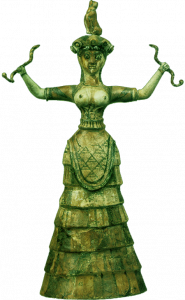
She was depicted as a woman holding snakes in her hands, doves on her shoulders and sitting among animals.
For her sake they held celebrations where they danced and played sports. In the spring they celebrated their biggest festival, the taurokataphasia. In this celebration, young men and women performed acrobatic exercises on ferocious bulls.
The Minoans worshiped bulls, because they symbolized the drive and power of life. Symbols of their religion were the sacred horns of the bull and the double ax.
Writing
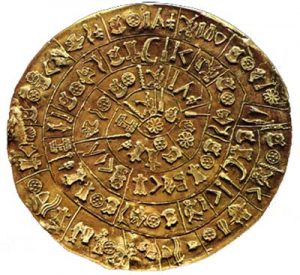
A little later, a new writing system came into use, Linear A. The writing was syllabic, that is, each point corresponded to a syllable, and it was the model for the development of Mycenaean writing. Traces of this script have been found mainly on pottery or engraved on inventory plates. However, this writing has not been deciphered
The Minoans were the first inhabitants of Greece to use writing. To write a word, they drew images of animals, plants, ships, vases, etc. This first writing is called hieroglyphics.
In Phaistos, archaeologists discovered a disk written in hieroglyphic script. So far no one has managed to read it. They say that a religious hymn is written on it. On the disk of Phaistos, the shapes have been written with seals. It is the oldest example of typography.
Later the Minoans discovered a simpler script, called Linear A.
The daily life of the Minoans
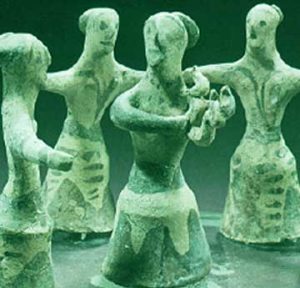
The fertile land of Crete produced abundant wheat, barley, olives, and grapes. Beekeeping was also very developed. Some of their products were brought to the palace and stored in huge warehouses. This was a tax they had to pay to Minos.
All the men were dressed simply. They wore only a small piece of cloth wrapped around their waist On the contrary, the women’s clothes were elegant and luxurious. They wore fancy long skirts, short aprons, thin shirts, coats and scarves. They were dyed and combed with care, just like today’s women.
They wore hats, ribbons and jewelry on their heads. They were engaged in household chores and weaving. There were looms in almost every house. They wore other fabrics and linen, but also very fine and transparent fabrics with beautiful designs. They had the same freedoms and the same rights as men.
They also took part in festivals, competitions and hunting. The children of the Minoans were shot from Psikra. They played, like today’s children, hunting and wrestling, but also board games, such as zatrikio, which resembles today’s chess, poles and ankles.
The Minoan food
Scientists, after studying the remains of food they discovered in pottery and cooking utensils of the time, found what the Minoans ate and drank. Their diet, therefore, included oil, nuts, figs, pomegranates, spices, legumes, meat, fish, milk and wine and even retsina.
Archaeologists, in order to make known to the world the results of this research, organized exhibition entitled “Minoan and Mycenaean flavors”, which toured many cities abroad.
The art of the Minoans
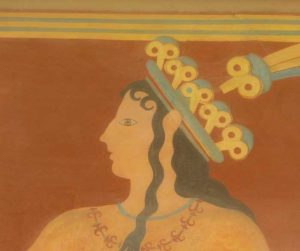
The art of seals was also developed in Phoenician Crete. The Minoan merchants, when concluding an agreement, used stamps to sign. The craftsmen who made them polished precious stones and engraved various shapes on them. No seal was the same as the other. Many Minoans wore their seals like rings.
There were also goldsmiths, where goldsmiths made gold stamps and beautiful jewelry, such as bracelets, rings, earrings and more.
The Minoans, however, were also great painters. They painted magnificent murals on the walls of their houses. Archaeologists have discovered in the palace of Knossos, but also in other mansions, frescoes of great art. The subjects of the frescoes were taken by the Minoans from nature and from religious ceremonies.
They painted lilies, birds, animals, dolphins, princes and lords, but also priestesses, bulls, acrobats, etc. The happy culture of the Minoans lasted over 1,500 years.
The end of the Minoan civilization
The Minoan civilization declined at the end of the 15th century. BC, however, the exact cause remains unknown. The most accepted working hypothesis is linked to the cosmogenic eruption of the Thera volcano and the earthquakes that destroyed cities along the Minoan trade routes, which had dramatic economic consequences.
The eruption of the volcano did not directly affect life on the island – located 70 miles south of Thira – but the damage was extensive. The consequences of the explosion affected entire generations, while the archaeological research revealed evidence of an invasion in the middle of the 15th century. e.g. Palaces in central and southern Crete were destroyed and settlements were abandoned. The invaders overthrew the Minoan government and took control of the island, marking the end of the era of Cretan rule.
Despite the sudden ending, the influence of the Minoan civilization survived. The Minoan tradition remained alive even after the disasters of 1500 BC. The conquest of Knossos by the Mycenaeans around 1450 BC. paved the way for the transmission of the most brilliant Cretan achievements to mainland Greece and wrote a new page in History.
